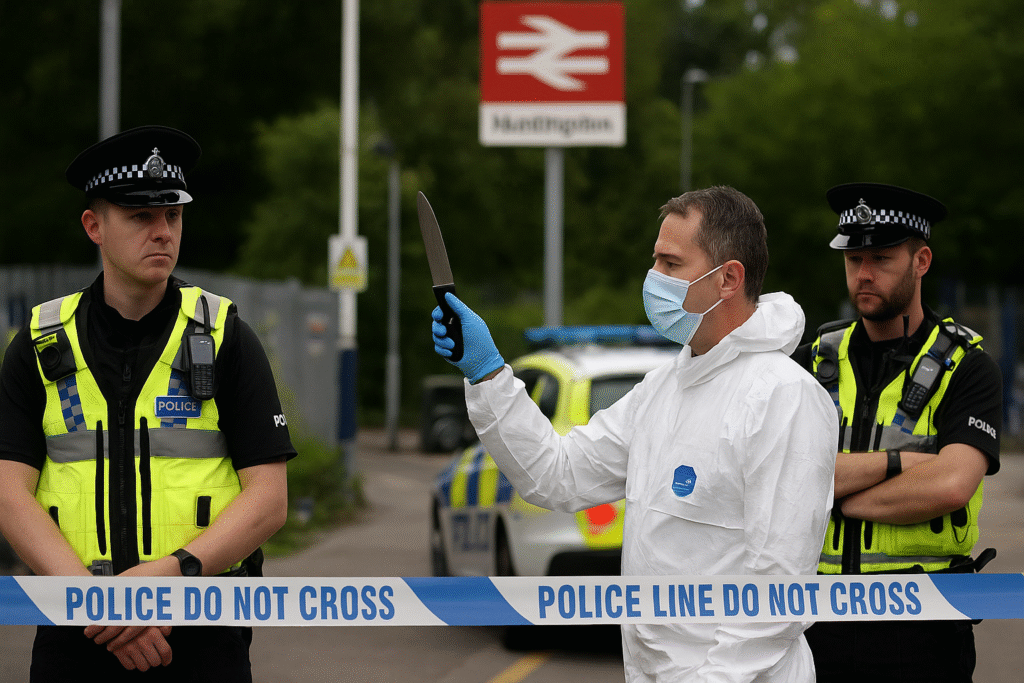A shocking stabbing attack on a London-bound train over the weekend has once again raised urgent questions about Britain’s persistent knife-crime crisis.
Nine people were seriously injured in the assault, which took place on a train traveling through central England on Saturday evening. Police have since charged a 32-year-old British man with ten counts of attempted murder. He has not yet entered a plea.
Home Secretary Shabana Mahmood condemned the incident in Parliament on Monday, acknowledging that knife violence “claims far too many lives in our country.”
Knife Crime: A Persistent National Problem
Despite repeated promises by successive governments, knife violence remains one of the UK’s most pressing public safety concerns.
According to the Office for National Statistics (ONS), police recorded 51,527 knife-related offenses in England and Wales in the 12 months leading up to June 2025 (excluding Greater Manchester). Of these, 196 were homicides.

Although that figure represents a 5% drop from the previous year, knife attacks continue to devastate communities across Britain.
The Scope of Fatal Stabbings
“Knife crime is a serious social concern — but it shouldn’t lead to moral panic,” said Iain Overton, Executive Director of Action on Armed Violence, in an interview with CNN.
From March 2023 to March 2024, there were 570 homicides in England and Wales — 262 involving knives or sharp objects. Kitchen knives remain the most commonly used weapon, while firearms accounted for only 22 deaths.
Teen victims are particularly vulnerable: 83% of teenagers killed in that period died from knife wounds.
Hospital data from NHS England recorded 3,494 admissions for assault with a sharp object between April 2024 and April 2025. Nearly 90% of victims were male, and 16% were under 18.
Scotland and Northern Ireland also reported fatal stabbings — 28 and four, respectively, between 2023 and 2024.
In comparison, the United States recorded 1,704 knife-related deaths in 2023, according to the CDC. The homicide rate in England and Wales — 9.5 per million — remains far below the 68 per million recorded in the U.S.
What’s Fueling Britain’s Knife-Crime Problem?
Experts say the rise in knife crime cannot be separated from broader social challenges.
The Local Government Association describes the issue as “multifaceted,” linking it to poverty, mental health, family instability, and school exclusion.
Dr. Siddhartha Bandyopadhyay, from the University of Birmingham, noted that “social deprivation and a lack of opportunity” are consistent drivers.
Criminologist James Alexander, of London Metropolitan University, said the pattern of knife violence has changed drastically in the last decade.
“Ten years ago, most youth knife crime was linked to gangs,” Alexander explained. “Now it’s unpredictable. We see young people with no criminal history being arrested for carrying or using knives.”
He added that fear often motivates youth to carry weapons. “Many don’t intend to use them — they just don’t feel safe without one,” he said.
The Government’s Response
During the 2024 general election, the Labour Party vowed to halve knife crime within a decade.
Since taking power, the government claims to have removed nearly 60,000 knives from streets through police operations and amnesty programs. It has also banned zombie knives and ninja swords, while tightening age checks for online knife sales.
Home Secretary Mahmood told Parliament this week that knife-related offenses have fallen 5%, with knife homicides down 18% in the past year.
Yet critics argue that enforcement alone cannot solve the issue.
“This isn’t just a policing problem,” said Overton. “Cuts to youth and mental-health services, poverty, and child exploitation all feed into violence. Prevention is the real solution.”
Early Intervention Programs Offer Hope
Experts point to Operation Divan, a North Yorkshire Police initiative, as a promising example. The program works with young people identified as being at risk of knife involvement, holding discussions and offering community support.
“There’s huge potential for early diversion through education and mentoring,” said Bandyopadhyay.
Alexander agreed that local programs often work — but funding is the biggest challenge. “There are amazing interventions, but they don’t last. When funding runs out, the progress disappears,” he said.
The Bigger Picture
Knife crime in Britain may not match the scale of gun violence seen elsewhere, but its emotional and social impact is undeniable.
Experts say solving the issue requires investment in prevention, education, and youth support — not just stronger laws.
As Britain debates the path forward, the message from communities, police, and researchers is clear: reducing knife crime will take more than arrests. It will take rebuilding trust, opportunity, and safety — one community at a time.














Leave a Reply